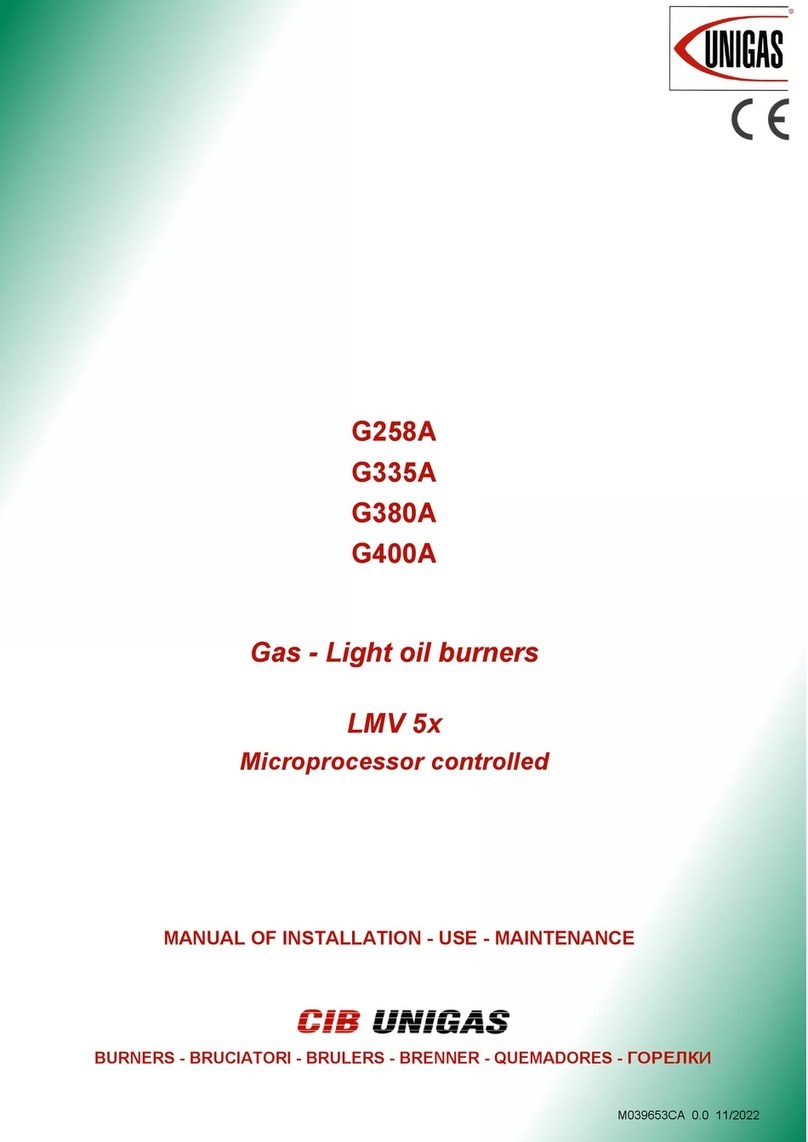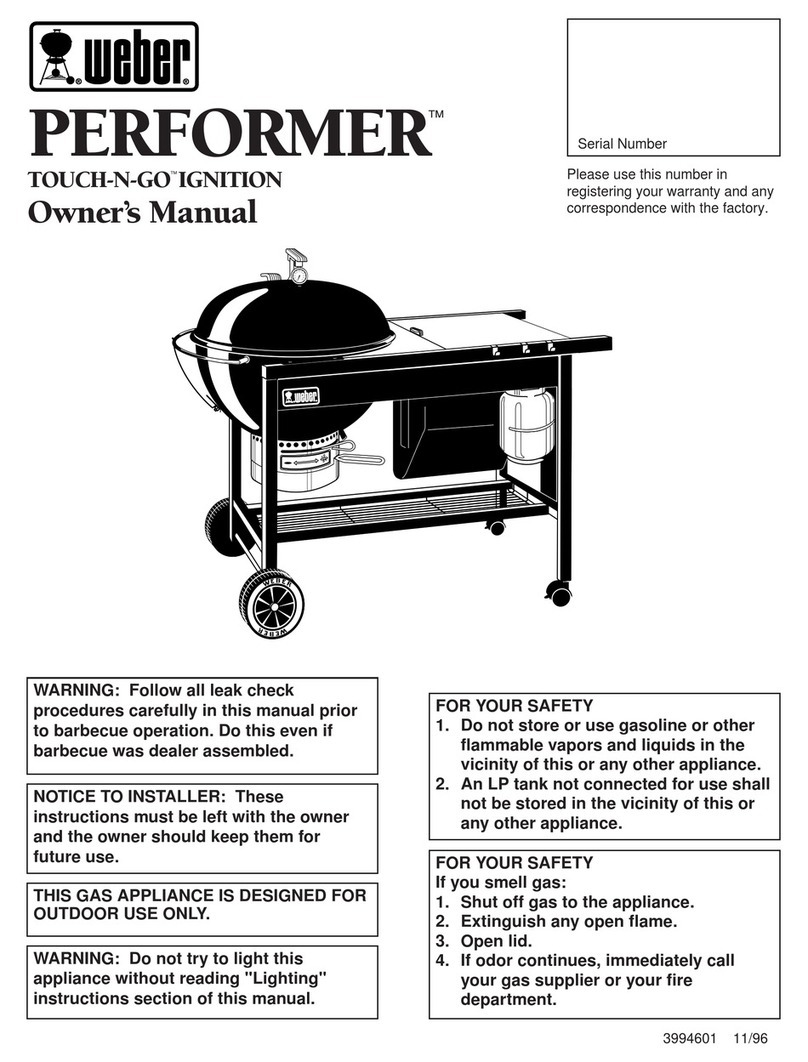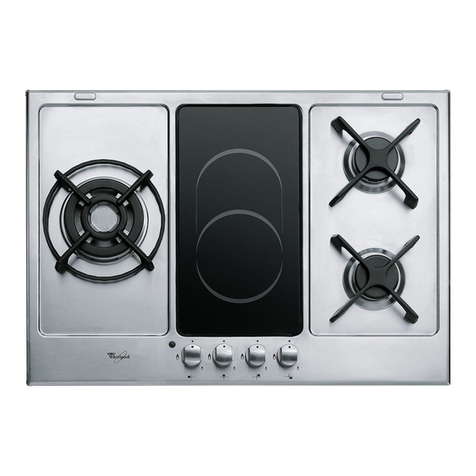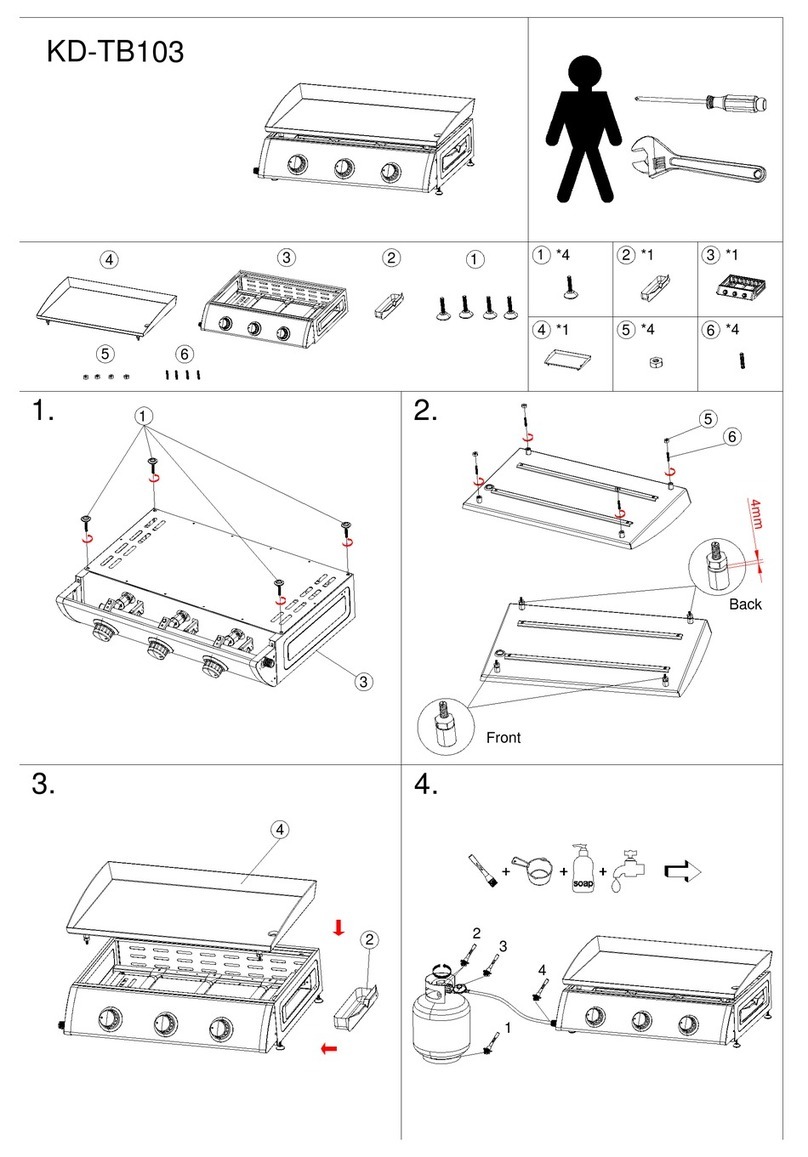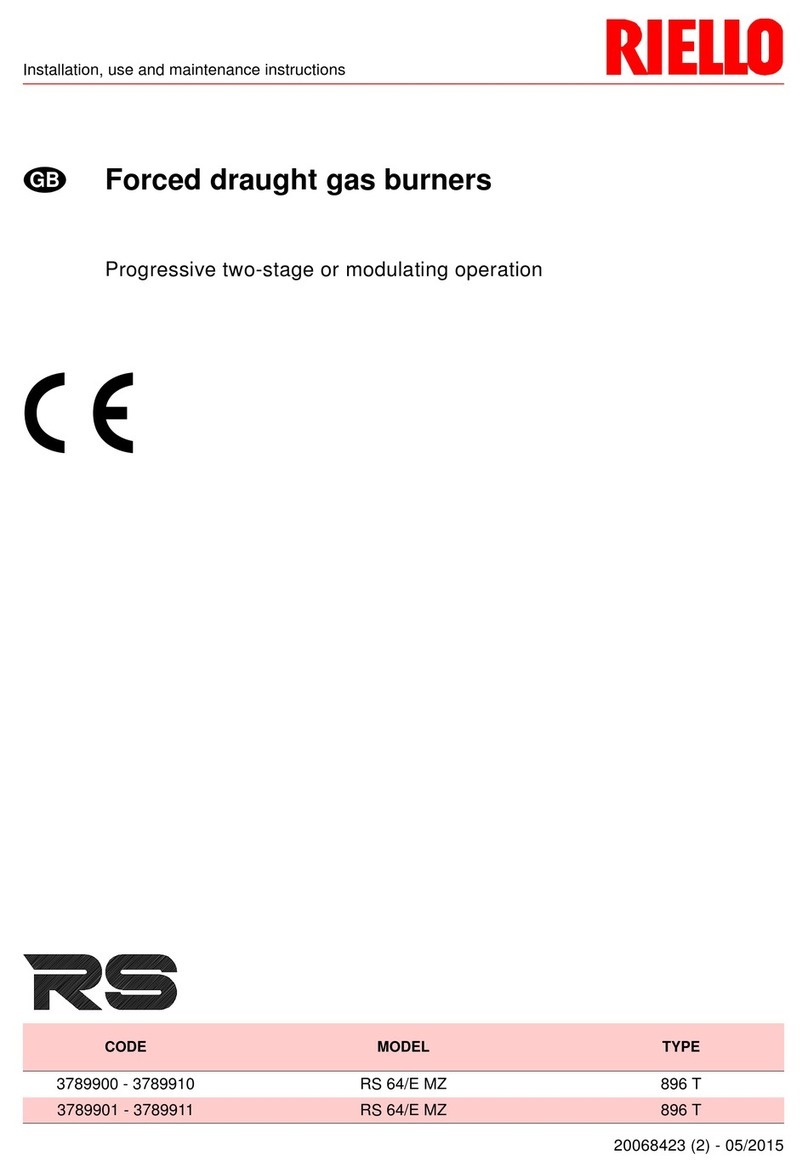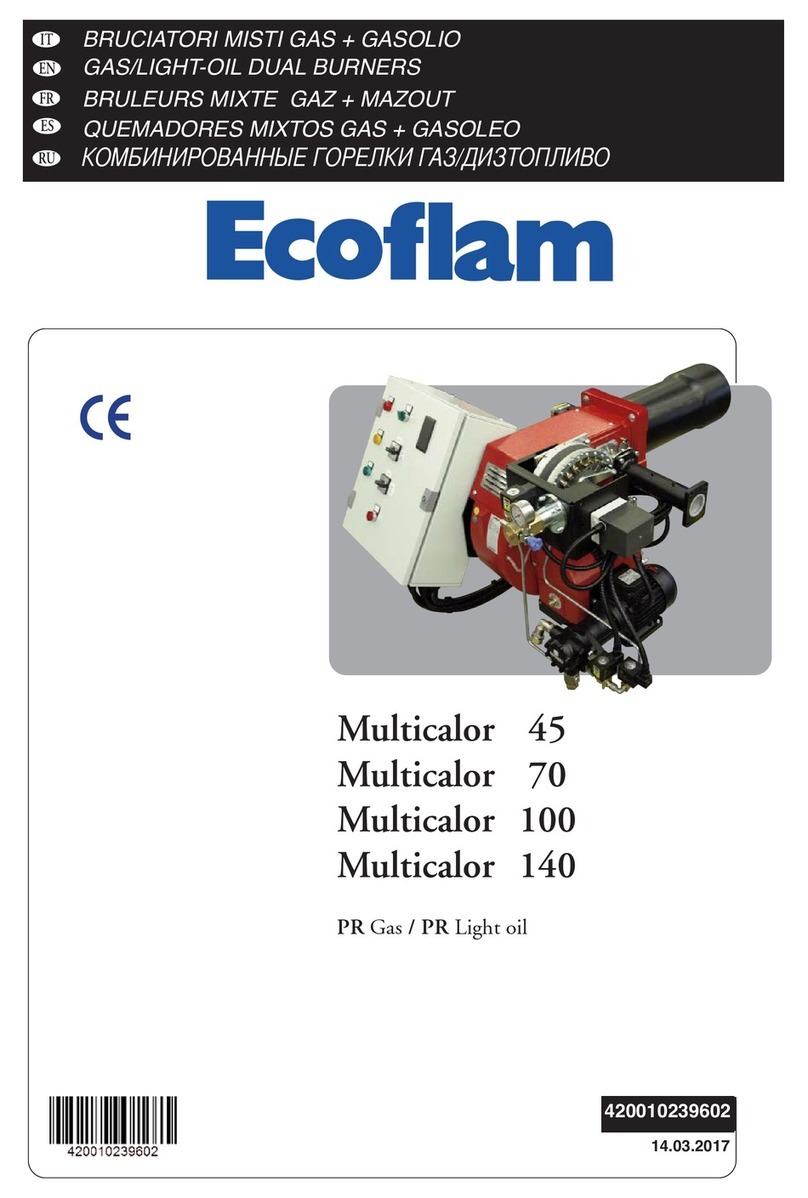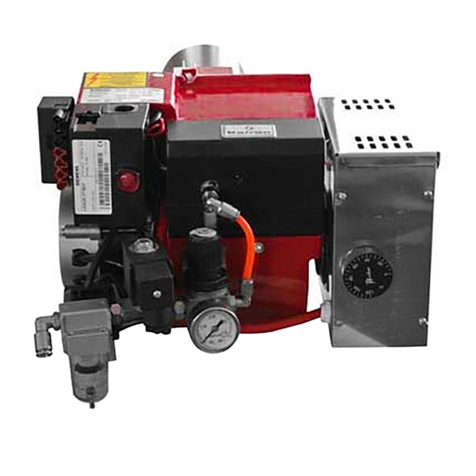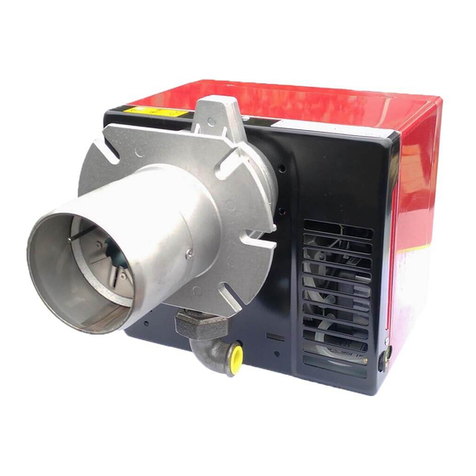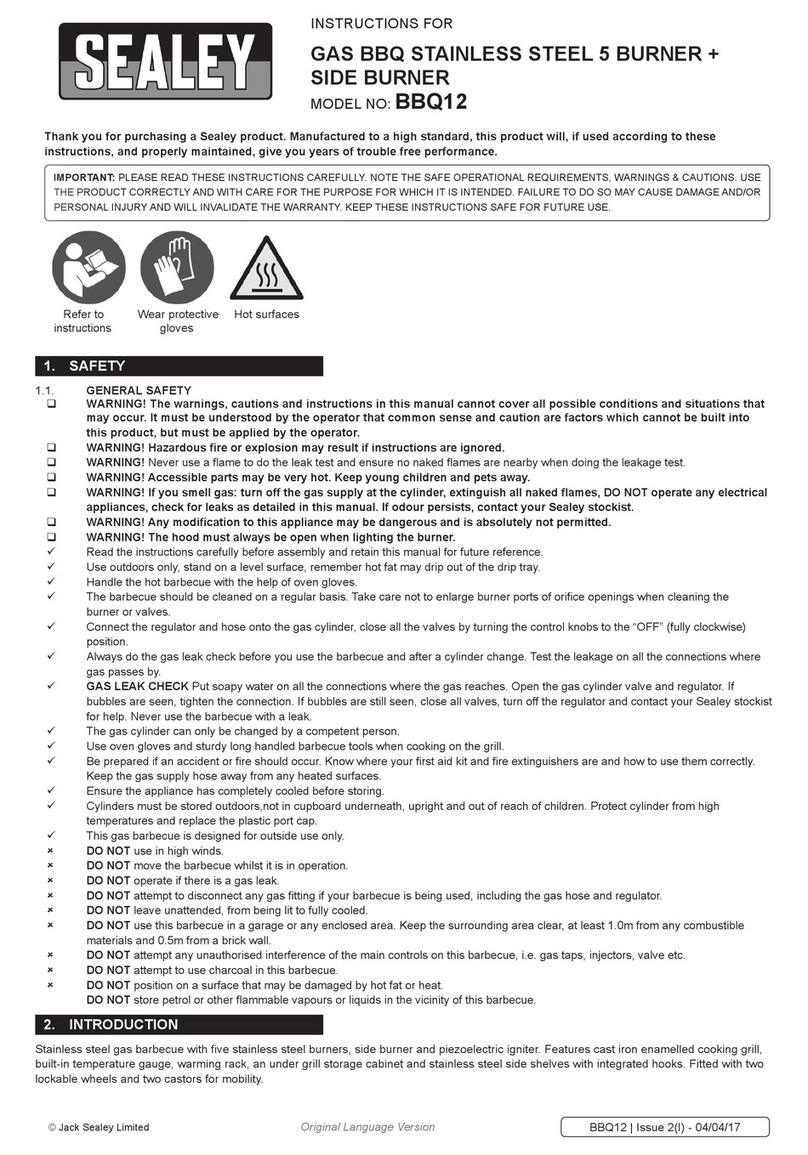Kromschroeder BIO 50 User manual

CONTENTS
· Edition 09.22 · EN · 03250472
DE, EN, FR, NL, IT, ES, DA, SV, NO, PT, EL, TR, CS, PL, RU, HU – www.docuthek.com
Burners for gas BIO, BIOA, BIOW
1 Safety ................................1
2 Checking the usage .....................2
3 Installation ............................2
4 Wiring................................5
5 Preparing commissioning.................6
6 Commissioning ........................9
7 Maintenance..........................11
8 Assistance in the event of malfunction ......13
9 Accessories ..........................14
10 Technical data .......................15
11 Logistics ............................15
12 Disposal ............................15
13 Declaration of Incorporation .............16
14 Certification .........................16
1 SAFETY
1.1 Please read and keep in a safe place
Please read through these instructions care-
fully before installing or operating. Following the installa-
tion, pass the instructions on to the operator. This unit
must be installed and commissioned in accordance
with the regulations and standards in force. These
instructions can also be found at www.docuthek.com.
1.2 Explanation of symbols
1, 2, 3, a, b, c = Action
➔= Instruction
1.3 Liability
We will not be held liable for damage resulting from
non-observance of the instructions and non-com-
pliant use.
1.4 Safety instructions
Information that is relevant for safety is indicated in the
instructions as follows:
DANGER
Indicates potentially fatal situations.
WARNING
Indicates possible danger to life and limb.
CAUTION
Indicates possible material damage.
All interventions may only be carried out by qualified
gas technicians. Electrical interventions may only be
carried out by qualified electricians.
1.5 Conversion, spare parts
All technical changes are prohibited. Only use OEM
spare parts.
OPERATING INSTRUCTIONS

BIO · Edition 09.22
EN-2
2 CHECKING THE USAGE
Burner for heating industrial thermoprocessing equip-
ment. For installation in a burner block or for use with
an extended, heat-resistant burner tube. For natural
gas, town gas and LPG. Other types of gas on request.
This function is only guaranteed when used within the
specified limits– see also page 15 (10 Technical
data). Any other use is considered as non-compliant.
2.1 Type label
Construction stage, rated capacity Qmax, gas type and
diameter of gas measuring orifice (as of construction
stageE)– see type label.
Elster GmbH
Osnabrück, Made in Germany
BIO 80HB-100/35-(16)F
84021014
P 150 kW
Ø 13 mm
.3322
2.2 Type code
BIO, ZIO Burner for gas
BIOA Burner for gas, with aluminium housing
BIOW Burner for gas, with ceramic fibre
insulation (RCF)
50-140 Burner size
RCold air
KFlat flame
HHot air/high furnace temperature
BNatural gas
DCoke oven gas, town gas
GPropane, propane/butane, butane
MPropane, propane/butane, butane (with
mixer)
LLow calorific value gas
Fbiogas
LTorch
RReduced capacity
-X X mm length of steel tube as of furnace
flange (L1)
/X X mm distance from furnace flange to
front edge of burner head (L2)
-(X) Burner head identifier
A-Z Construction stage
BWith purge air bore holes
HHigh temperature version
ZSpecial version
2.3 Part designations
1
3
4
5
6
7
2
1 Burner insert
2 Type label
3 Gas housing gasket
4 Air housing
5 Burner tube set
6 Mounting gasket (not included in the delivery)
7 Operating instructions – for more documents
and calculation tools, see www.adlatus.org
2.4 Burner head
➔Check letter marking and identification marks on
the burner head using the information provided
on the type label.
3 INSTALLATION
3.1 Conical burner block
➔For industrial furnaces and kilns and for burning in
an open combustion chamber.
➔Control: High/Low, continuous.
➔Type of burner head: R.
➔Max. capacity: 100%.
➔We recommend the cold air operating mode; oth-
erwise the nitric oxide values will be too high.

BIO · Edition 09.22
EN-3
3.2 Cylindrical burner block
➔For industrial furnaces and kilns and for burning in
an open combustion chamber.
➔Control: High/Low, High/Low/Off, continuous.
➔Type of burner head: R, H.
➔Max. capacity: 100%.
➔Normal to medium flow velocity.
3.3 Tapered burner block
➔For industrial furnaces and kilns and for burning in
an open combustion chamber.
➔Control: High/Low, High/Low/Off, continuous.
➔Type of burner head: R, H.
➔
Max. capacity: approx. 80%, depending on the
outlet diameter of the burner block.
➔Medium to high flow velocity.
3.4 Flat flame burner block
➔For industrial furnaces and kilns and for burning in
an open combustion chamber.
➔Control: High/Low, High/Low/Off, continuous (lim-
ited turndown).
➔Type of burner head: K.
➔Capacity range: 40–100%.
3.5 Burners with attachment tube
➔
Position of the burner head near the interior furnace
wall ( L2 = LO ± 50mm).
L2= LO± 50 mm
LO
1
➔
Do not fit the attachment tube 1directly in the
furnace wall.
➔Furnace temperature ≤600°C.
3.6 Radiant tube heating
2
➔
Reduce the outlet diameter of the radiant tube
using an orifice 2to the point where a pressure
loss of approx. 10mbar occurs at the burner’s
rated capacity.
3.7 Hot air generation
➔At flow velocities of > 15m/s, the flame tube FPT
is used to protect the flame from being cooled.

BIO · Edition 09.22
EN-4
3.8 Installation on the furnace
➔
When installing, always ensure that when the burner
is mounted, it is sealed tightly on the furnace wall.
1 2
3 4
3.9 Air connection, gas connection
BIO
GA
LA
BIOW
GA
LA
(14,16,17)
Type Gas connec-
tion GA
Air connec-
tion LA*
BIO 50 Rp 1/2 Rp 1/2
BIOA 65 Rp 1/2 Ø 48mm
BIO 65 Rp 3/4 Rp 1 1/2
BIO 80 Rp 3/4 Rp 2
BIO 100 Rp 1 Rp 2
BIO 125 Rp 1 1/2 DN 65
BIO 140 Rp 1 1/2 DN 80
BIOW 65 Rp 3/4 DN 65
BIOW 80 Rp 3/4 DN 80
BIOW 100 Rp 1 DN 80
BIOW 125 Rp 1 1/2 DN 100
BIOW 140 Rp 1 1/2 DN 125
* Up to burner size 100, threaded connection;
as from burner size 125, flanged connection,
BIOA 65: tube connection.
➔
Threaded connection to DIN2999, flange dimen-
sions to DIN2633, PN 16.
➔
Install flexible tubes or bellows units to prevent
mechanical stress or transmission of vibration.
➔Ensure that the gaskets are undamaged.
DANGER
Risk of explosion!
– Ensure the connection is air-tight.
➔
On delivery, the threaded gas connection is situated
opposite the air connection; it can be rotated in
increments of 90°.
3.10 Connection to ANSI/NPT
➔An adapter set is required for connection to ANSI/
NPT, see page 14 (9 Accessories)
Type Gas connec-
tion GA
Air connec-
tion LA
BIO 50 ½–14 NPT 1½–11.5 NPT
BIO 65 ½–14 NPT Ø 1.89"
BIO 65 ¾–14 NPT 1½–11.5 NPT
BIO 80 ¾–14 NPT 2–11.5 NPT
BIO 100 1–11.5 NPT 2–11.5 NPT
BIO 125 1½–11.5 NPT Ø 2.94"
BIO 140 1½–11.5 NPT Ø 3.57"
BIOW 65 ¾ NPT Ø 2.94"
BIOW 80 ¾ NPT Ø 3.57"
BIOW 100 1 NPT Ø 3.57"
BIOW 125 1½ NPT Ø 4.6"
BIOW 140 1½ NPT Ø 5.6"
➔
BIO 50 to BIO 100: use NPT adapter Jfor air
connection LA and NPT thread adapter Hfor gas
connection GA.
H
J
GA
LA
➔
BIO 125, BIO 140, BIOW: weld flange Kto air
pipe Pfor air connection LA and use NPT thread
adapter Hfor gas connection GA.

BIO · Edition 09.22
EN-5
BIO 125 and BIO 140
H
K
GA
LA
P
BIOW
GA
LA K
P
H
(14,16,17)
3.11 Pilot connections on the BIO..L
➔Air connection la: Rp3/8".
➔
Gas connection ga (as from burner size 65):
Rp1/4".
la
ga
➔Pilot capacity: 1.5kW.
3.12 Installing the burner insert
WARNING
– BIOW: do not damage the surface of the
insulation. Avoid the formation of dust.
➔
The burner insert can be rotated to the required
position in increments of 90°.
1 Insert the gas housing gasket between the burner
insert and the air housing.
2 Tighten burner insert in a crosswise fashion:
BIO(A) 50–100 with max. 15 Nm (11 lb ft),
BIO 125–140 with max. 30Nm (22lbft).
4 WIRING
DANGER
Electric shocks can be fatal!
– Before working on possible live components,
ensure the unit is disconnected from the power
supply.
➔For the ignition and ionization cables, use (un-
screened) high-voltage cable:
FZLSi 1/6 up to 180°C (356°F),
Order No. 04250410, or
FZLK 1/7 up to 80°C (176°F),
Order No. 04250409.
Z
I
Flame rod I
➔
Install the ionization cable well away from mains
cables and interference from electromagnetic
sources and avoid external electrical interference.
Max. length of ionization cable – see automatic
burner control unit operating instructions.
➔
Connect the flame rod to the automatic burner
control unit via the ionization cable.
Spark electrode Z
➔Length of ignition cable: max. 5 m (15ft), recom-
mended <1m (40").
➔For permanent ignition, max. ignition cable length
1 m(40").
➔
Lay the ignition cable individually and not in a metal
conduit.

BIO · Edition 09.22
EN-6
➔Install the ignition cable separately from ionization
and UV cables.
➔A ≥7.5kV, ≥12mA ignition transformer is recom-
mended; 5kV for integrated pilot.
Flame rod and spark electrode
1
2 3 4
5
6 Connect the PE wire for burner ground to the burn-
er insert. In the case of single-electrode operation,
route the PE wire from the burner insert directly to
the terminal on the automatic burner control unit.
WARNING
High-voltage risk!
– It is essential that a high-voltage warning label
be attached to the ignition cable.
7 For more detailed information on how to wire the
ionization and ignition cables, refer to the operating
instructions and connection diagrams of the auto-
matic burner control unit and ignition transformer.
5 PREPARING COMMISSIONING
5.1 Safety instructions
➔
Agree on settings and commissioning of the burner
with the system operator or manufacturer.
➔
Check the entire system, upstream devices and
electrical connections.
➔Note the operating instructions for individual con-
trols.
DANGER
Risk of explosion!
– Please observe the appropriate precautions
when igniting the burner.
– Pre-purge the furnace chamber or radiant tube
with air (5x volume) before every ignition
attempt.
– Fill the gas line to the burner carefully and
correctly with gas and vent it safely into the
open air – do not discharge the test volume into
the furnace chamber.
DANGER
Risk of poisoning!
– Open the gas and air supply so that the burner
is always operated with excess air– otherwise
CO will form in the furnace chamber. CO is
odourless and poisonous! Conduct a flue gas
analysis.
– The burner must only be commissioned by
authorized trained personnel.
➔If the burner does not ignite even though the auto-
matic burner control unit has been switched on and
off several times: check the entire system.
➔After ignition, monitor the flame and the gas and
air pressure measured on the burner. Measure the
ionization current. Switch-off threshold– see au-
tomatic burner control unit operating instructions.
+μA –
Z
I
➔
The burner must only be ignited at low-fire rate
(between 10 and 40% of the rated capacityQmax)–
see type label.
5.2 Determining the gas and combustion air
flow rates
➔Qgas: Gas flow rate in m3/h (ft3/h)
➔PB: Burner capacity in kW (BTU/h)
➔Hi: Gas heating value in kWh/m3(BTU/ft3)
➔Qair: Air flow rate in m3(n)/h (SCFH)
➔ λ: Lambda, air index
➔
Lmin: Minimum air requirement in m3(n)/m3(n) (SCF/
SCF)
➔
Information on the gas quality supplied can be
obtained from the gas supply company.
Common gas qualities
Gas type Heating value
HuHoLmin
kWh/
m3(n)
BTU/
SCF
m3(n)/
m3(n)
(SCF/
SCF)
Natural gas H 11.0 1114 10.6
Natural gas L 8.9 901 8.6
Propane 25.9 2568 24.4
Low calorific
value gas 1.7–3 161–
290 1.3–2.5
Butane 34.4 3406 32.3
➔
Data in kWh/m
3
(n) refer to the lower heating val
-
ueH
u
and data in BTU/SCF refer to the higher
heating valueHo(gross calorific value).

BIO · Edition 09.22
EN-7
➔
A minimum air excess of 20% (lambda=1.2) should
be set in a cold furnace for initial adjustment since
the air volume falls as the temperature rises.
➔
Fine adjustment should be carried out at max.
furnace temperature and at as high a capacity
demand as possible.
5.3 Notes on the flow rate curve
➔
If the gas density in the operating state differs from
that reflected in the flow rate curve, convert the
pressures according to the local operating state.
pB = pM .
δ
B
δ
M
➔
δM: Gas density reflected in the flow rate curve
in kg/m3(lb/ft3)
➔ δB: Gas density in operating state in kg/m3(lb/ft3)
➔pM: Gas pressure reflected in the flow rate curve
➔pB: Gas pressure in operating state
5.4 Burners without gas measuring orifice
1 Read the gas pressure pgas and air pressure pair
from the enclosed flow rate curve for cold air on
the basis of the calculated flow ratesQ.
[mbar (inch WC)]
[m3/h (ft3/h)]
pgas pair
pair
pgas
Qair
Qgas
➔
Note possible capacity changes due to positive
or negative pressures in the furnace/combustion
chamber. Add positive pressures or subtract neg-
ative pressures.
➔As not all the effects caused by the equipment are
known, setting the burner using the pressure values
is only approximate. It is possible to set the burner
precisely by measuring the flow rates or flue gas.
5.5 Burners with gas measuring orifice
1 Read the differential pressureΔpgas and air pres-
surep
air
from the flow rate curve for cold air on the
basis of the calculated flow rates.
[mbar (inch WC)]
[m3/h (ft3/h)]
Δpgas pair
pair
pgas
Qair
Qgas
pgas
∆pair
➔Note possible capacity changes (air) due to pres-
sure loss in the furnace/combustion chamber. Add
positive pressures or subtract negative pressures.
➔
The differential gas pressure Δp
gas
measured on
the integrated gas measuring orifice is independent
of the furnace chamber pressure.
WARNING
– If reducing fittings or manual valves with internal
thread are installed, Δpgas on the integrated gas
measuring orifice is reduced.
➔Reducing fitting with internal and external thread:
deviation from the flow rate curves may occur when
the cross-section of the reducing fitting differs from
that of the threaded gas connectionGA or when
a manual valve is screwed directly into the burner.
➔
Reducing nipple with external thread at both ends:
no deviation from the flow rate curves occurs.
➔
Ensure an undisturbed flow to the measuring orifice!
➔As not all the effects caused by the equipment are
known, setting the burner using the pressure values
is only approximate. It is possible to set the burner
precisely by measuring the flow rates or flue gas.
5.6 Restrictors
➔
The air volume required for the low-fire rate at a
given air pressure is determined by the ignition
position of a butterfly valve, a bypass hole in the air
valve or an external bypass with restrictor.
➔
Burners as from construction stage E (see type
label) are equipped with gas flow adjustment to
replace the restrictor in the gas pipe.
5.7 Hot air compensation
➔
The combustion air pressure p
air
must be increased
in hot air operating mode (lambda=constant).
0 50 100 150 200 250 300 350 400 450 500 550
600
100
150
200
300
250
Air temperature [°C]
Air pressure p
air
[%]
➔The gas pressure is increased by 5–10mbar.
➔The total burner capacity Pgas rises as the air tem-
perature increases.
0 50 100 150 200 250 300 350 400 450 500 550 600
100
110
120
Air temerature [°C]
Total capacity Ptot [%]

BIO · Edition 09.22
EN-8
5.8 Burners with electrodes with air connection
➔Burner head marking (..D) or (..E)
purge air tube
purge air nozzle
d=4.5mm
Rp 1/4
10
20
30
40
123
p [mbar]
0
10
20
30
40
0
123
Pressures for purges electrodes
Q purging air [m
3
/h]
➔
A purge air volume of approx. 1.5 to 2m³/h per
electrode is recommended.
➔
The purge air may not be switched off until the
furnace is cold and formation of condensation is
no longer possible.
5.9 Setting the air pressure for low fire and
high fire
1 Shut off the gas and air supply.
BIO
➔
Air measuring nipple L, outside dia. = 9mm (0.35").
2
L
➔Loosen the screw 2turns.
3
L
4 Fully open the air supply.
5
p
atm.
pair
0
➔patm. = atmospheric pressure.
BIOA
➔
Air measuring nipple L, outside dia. = 9mm (0.35").
1
L
➔Loosen the screw 2turns.
2
L
3 Fully open the air supply.
4
p
atm.
pair
0
➔patm. = atmospheric pressure.
Low-fire rate
➔
The burner must only be ignited at low-fire rate
(between 10 and 40% of the rated capacity Q
max
–
see page 2 (2.1 Type label)).
5 Reduce the air supply on the air control valve and
set the desired low-fire rate, e.g. using a limit switch
or mechanical stop.
➔
On air control valves with bypass, the bypass orifice
should be determined on the basis of the required
flow rate and the existing supply pressure if required.
High-fire rate
6 Set the air control valve to high-fire rate.
7 Set the required air pressure pair on the air restric-
tor upstream of the burner.
8 When using air restricting orifices: check the air
pressurepair.
5.10 Preparing the gas pressure measurement
for low fire and high fire
1 Connect all measuring devices for subsequent fine
adjustment of the burner.
➔Leave the gas supply closed.
➔
Gas measuring nipple G, outside dia.= 9mm
(0.35").
5.11 Burners without gas measuring orifice
1 Read the gas pressure p
gas
for the required flow
rateQ from the enclosed flow rate curve for cold
air.
[mbar (inch WC)]
[m3/h (ft3/h)]
pgas pair
pair
pgas
Qair
Qgas

BIO · Edition 09.22
EN-9
BIO..50
1
G
➔Loosen the screw 2turns.
2
G
BIOA
1
G
➔Loosen the screw 2turns.
2
G
5.12 Burners with gas measuring orifice
1 Read the differential pressure for the required gas
flow rateQ from the enclosed flow rate curve for
cold air.
[mbar (inch WC)]
[m3/h (ft3/h)]
Δpgas pair
pair
pgas
Qair
Qgas
pgas
∆pair
2 p1: gas pressure upstream of the measuring orifice,
p2: gas pressure downstream of the measuring
orifice. Measuring range: select approx. 15mbar.
3
G
G
➔Loosen the screws 2turns.
4
p2
p1
5.13 Integrated pilot on the BIO..L
➔
Air pressure test nipple l, outside dia. = 9mm
(0.35").
➔
Gas pressure test nipple g, outside dia. = 9mm
(0.35").
1
g
l
➔Loosen the screws 2turns.
2
g
l
➔Pilot:
pgas = 30–50mbar,
pair = 30–50mbar.
➔Check flame stability and ionization current.
➔
The gas and air pressure of the integrated pilot
must be higher than the gas and air pressure of
the main burner.
6 COMMISSIONING
6.1 Igniting and adjusting the burner
WARNING
– Ensure adequate ventilation of the furnace
chamber before each burner start!
➔The burner body will become hot during operation
with preheated combustion air. Provide protection
against accidental contact as required.
1 All valves of the installation must be checked for
tightness before ignition.
6.2 Setting the low-fire rate
1 Set the valves to ignition position.
2 Limit the maximum gas volume.
➔
Should an adjustable gas restrictor be installed
upstream of the burner, open the restrictor by ap-
prox. a quarter.
➔
On burners with integrated gas flow adjust-
ment (BIO 65–140): on delivery, the flow rate
restrictor is 100% open. Close the flow rate rate
restrictor with approx. 10turns:
3
4

BIO · Edition 09.22
EN-10
➔Loosen the lock nut only.
5
Q-
➔Set flow rate Q.
6
7
8 Gaszufuhr öffnen.
9 Ignite the burner.
➔
The safety time of the automatic burner control unit
starts to elapse.
10 If no flame forms, check and adjust the gas and air
pressures of the start gas adjustment.
11 In the case of operation with bypass (e.g. when
using an air/gas ratio control): check the bypass
nozzle and adjust if required.
12 In the case of operation without bypass (e.g. when
using an air/gas ratio control without bypass): in
-
crease the low-fire rate setting.
13 Check the basic setting or bypass of the air control
valve.
14 Check the position of the restrictor in the air line.
15 Check the fan.
16 Reset the automatic burner control unit and re-ig-
nite the burner.
➔
The burner ignites and proceeds to normal op-
eration.
17 Check flame stability and ionization current at low-
fire rate. Switch-off threshold– see automatic
burner control unit operating instructions.
+μA –
Z
I
18 Monitor flame formation.
19 Adjust the low-fire rate settings if required.
20 If no flame is detected– see page 13 (8 Assis-
tance in the event of malfunction).
6.3 Setting the high-fire rate
1 Set the air and gas circuit of the burner to high fire
while continuously monitoring the flame.
➔
Avoid CO formation– always operate the burner
with excess air when starting up!
➔Burners without gas measuring orifice: when
the desired maximum valve positions are reached,
set the gas pressure pgas using the restrictor up-
stream of the burner.
p
gas
0
patm.
➔
Burners with gas measuring orifice: set the
differential pressure Δpgas using the gas restrictor
or via the integrated flow adjustment.
p
1
p
2
0
∆p
2
3
➔Turn the lock nut 1/4 turn to the left only.
4
Q-
Q+
➔Set flow rate Q.
5
➔
Tighten the lock nut. Do not alter the flow rate
setting!
6
6.4 Readjusting the air flow rate
1 Check the air pressure pair on the burner and adjust
using the air restrictor if required.
2 When using air restricting orifices: check the air
pressure pair and rework the orifice if required.
DANGER
Risk of explosion and poisoning in case of burner
adjustment with insufficient air!

BIO · Edition 09.22
EN-11
– Adjust the gas and air supply so that the burner
is always operated with excess air– otherwise
CO will form in the furnace chamber. CO is
odourless and poisonous! Conduct a flue gas
analysis.
3 Measure the gas and air flow rates if possible. De-
termine the lambda value and readjust the settings
if required.
6.5 Tightness test
DANGER
Escaping gas!
Danger from a leakage at the gas connections.
– Check the gas connections on the burner for
leaks immediately after commissioning the
burner.
1 2
3 4
➔
Avoid condensation due to the furnace atmos-
phere entering the burner body. While the burner
is switched off, at furnace temperatures above
500°C (932°F), it must be cooled with a low air
volume – see page 11 (6.6 Cooling air).
6.6 Cooling air
➔
While the burner is switched off and depending on
the furnace temperature, there must be a certain air
flow for cooling the burner components.
0
12
14
8
4
10
6
2
16
BIO/ZIO*
BIO/ZIO..K..(..E)
BIO/ZIO..K
BIOW/ZIOW..(..E)..H
BIO/ZIO..(..E)
600
500
700
800
900
1000
1100
1200
1300
1400
1500
Tfurnace °C
% of cooling air
* also BIOW/ZIOW
➔
Diagram: the cooling air percentage specified in
the diagram refers to the operating flow rate for air.
➔Leave the air fan switched on until the furnace has
cooled down completely.
6.7 Blocking and recording the settings
1 Produce a measurement report.
2 Set the burner to low fire and check the settings.
3 Set the burner to low and high fire several times
while monitoring the pressure settings, flue gas
values and flame patterns.
4 Remove the measuring devices and close off the
test nipples– tighten the grub screws.
5 Block and seal the adjusting elements.
6 Induce a flame failure, e.g. by pulling the terminal
boot off the flame rod. The flame detector must
close the gas safety valve and signal a fault.
7 Switch the system on and off several times while
monitoring the automatic burner control unit.
8 Produce an acceptance report.
DANGER
Risk of explosion in case of CO being formed
in the furnace chamber! CO is odourless and
poisonous!
An incorrect change of the burner settings may
change the gas/air ratio and lead to unsafe operat-
ing conditions:
– All interventions may only be carried out by
qualified gas technicians.
7 MAINTENANCE
➔
Maintenance and function check every six months.
If the media are highly contaminated, this interval
should be reduced.
DANGER
Risk of explosion!
– Please observe the appropriate precautions
when igniting the burner.
– Maintenance work on the burner must be
carried out by authorized trained personnel only.
DANGER
Risk of burning!
– Outflowing flue gases and burner components
are hot.
➔
We recommend that all the gaskets removed during
maintenance work be replaced. The appropriate
gasket set is available separately as a spare part.
1 Check the ionization and ignition cables.
2 Measure the ionization current.
➔
The ionization current must be at least 5µA and
must not vary.
+μA –
Z
I
3 Disconnect the system from the electrical power
supply.
4 Shut off the gas and air supply– do not change
the restrictor settings.

BIO · Edition 09.22
EN-12
7.1 Checking the spark electrode and flame
rod
1
2
➔Ensure that the electrode length does not change.
3 Remove dirt from electrodes or insulators.
L
1
2
34
4 If the star 4or insulator 3is damaged, replace the
electrode.
➔Before changing the electrode, measure the total
lengthL.
5 Connect the new electrode with the spark plug1
using the dowel pin2.
6 Adjust spark plug and electrode to the measured
total lengthL.
7
8
➔Turning the spark plug makes it easier to feed the
electrode into the burner insert.
7.2 Checking the burner
Removing and installing burner insert BIOW
➔Do not damage the surface of the insulation.
➔Avoid the formation of dust.
1
2
3
➔If the burner insert is dismantled, the gas housing
gasket will have to be renewed.
4 Place the burner insert in a safe place.
➔Depending on the amount of dirt or wear: replace
the spark electrode/flame rod and dowel pin during
servicing– see page 12 (7.1 Checking the spark
electrode and flame rod).
➔Check burner head for dirt and thermal cracks.
WARNING
Risk of injury!
– Burner heads have sharp edges.
➔
When replacing any burner components: apply
ceramic paste to the screw connections in order to
avoid cold-setting– see page 14 (9 Accessories).
5 Check the electrode positions.
BIO..50
➔The front part of the insulator must protrude 4mm
from the burner air disc.
4 mm
BIO..65 to 140
➔The insulator must be flush with the front edge of
the burner air disc.

BIO · Edition 09.22
EN-13
➔
Distance of spark electrode from ground pin or gas
nozzle: 2± 0.5mm (0.08±0.02").
2 ± 0,5 mm
(0.08 ± 0.02 inch)
6 When the furnace chamber has cooled down,
check the burner tube and burner block through
the furnace flange.
➔Replace the gas housing gasket.
7 8
9
10
➔
Tighten burner insert in a crosswise fashion: BIO(A)
50 to 100 with max. 15Nm (11lb ft), BIO 125 to
140 with max. 30Nm (22lbft).
11 Connect the system to the electrical power supply.
12 Open the gas and air supply.
13 14
15 Set the burner to low fire and compare the pressure
settings to those stated in the acceptance report.
16 Set the burner to low and high fire several times
while monitoring the pressure settings, flue gas
values and flame patterns.
DANGER
Risk of explosion and poisoning in case of burner
adjustment with insufficient air!
– Adjust the gas and air supply so that the burner
is always operated with excess air– otherwise
CO will form in the furnace chamber. CO is
odourless and poisonous! Conduct a flue gas
analysis.
17 Produce a maintenance report.
8 ASSISTANCE IN THE EVENT OF
MALFUNCTION
DANGER
Electric shocks can be fatal!
– Before working on possible live components,
ensure the unit is disconnected from the power
supply.
DANGER
Risk of injury!
Burner heads have sharp edges.
– Burner inspection must only be performed by
authorized trained personnel.
➔If no issues are found when checking the burner,
proceed to the automatic burner control unit and
check for faults in accordance with the relevant
operating instructions.
? Fault
! Cause
• Remedy
? Burner does not function.
! Valves do not open.
• Check the voltage supply and wiring.
! Tightness control signals a fault.
• Check the valves for tightness.
• Note the tightness control operating instruc-
tions.
! Control valves do not move to low-fire rate posi-
tion.
• Check the impulse lines.
! Gas inlet pressure is too low.
• Check the filter for dirt.
• Check the gas supply.
! Air inlet pressure is too low.
• Check the fan and air supply.
! Gas and air pressures on the burner are too low.
• Check the restrictors.
• Check/adjust the start rate setting, see operat-
ing instructions for solenoid valve.
! Automatic burner control unit does not function
correctly.
• Check the device fuse.
• Note the automatic burner control unit operat-
ing instructions.
! Automatic burner control unit signals a fault.
• Check the ionization cable.
• Check the ionization current. The ionization
current must be at least 5μA– stable signal.
• Check whether the burner is adequately
grounded.
• Note the automatic burner control unit operat-
ing instructions.

BIO · Edition 09.22
EN-14
! No ignition spark is created.
• Check the ignition cable.
• Check the voltage supply and wiring.
• Check whether the burner is adequately
grounded.
• Check the electrode – see page 11 (7
Maintenance).
! Defective insulator on the electrode, ignition
spark jumps over incorrectly.
• Check the electrode.
? Burner performs a fault lock-out after oper-
ating faultlessly in normal operation.
! Incorrect gas and air flow rate settings.
• Check the differential pressures for gas and air.
! Automatic burner control unit signals a fault.
• Check the ionization cable.
• Check the ionization current. The ionization
current must be at least 5μA– stable signal.
! Burner head is dirty.
• Clean gas and air bore holes and air slots.
• Remove deposits.
! Excessive pressure fluctuations in the combus-
tion chamber.
• Ask Honeywell Kromschröder for control
concepts.
9 ACCESSORIES
9.1 Ceramic paste
For avoiding cold-setting on screw connec-
tions after replacing burner components.
Order No.: 050120009.
9.2 Adapter set
8× 8×
BIO 125–140BIO 50–100 BIOA 65
For connecting, burners BIO, BIOA to NPT/ANSI
connections.
Burner Adapt-
er set
Gas
con-
nection
Air
con-
nection
Order No.
BIO 50 BR 50
NPT
½"–14
NPT
1½"–
11.5
NPT
74922630
BIO 65 BR 65
NPT
¾"–14
NPT
1½"–
11.5
NPT
74922631
BIOA 65* – ½"–14
NPT Ø 1.89" 75456281
BIO 80 BR 80
NPT
¾"–14
NPT
2"–11.5
NPT 74922632
BIO 100 BR 100
NPT
1"–11.5
NPT
2"–11.5
NPT 74922633
BIO 125 BR 125
NPT
1½"–
11.5
NPT
Ø 2.94" 74922634
BIO 140 BR 140
NPT
1½"–
11.5
NPT
Ø 3.57" 74922635
* An NPT thread adapter is required for connection to the
gas circuit only.
Adapted set for BIOW on request.
9.3 Integrated pilot connections
Nozzle set BR 65–1 40 with NPT thread is required
for integrated pilots (sizes 165 and 200 on request).
Gas type Order No.
Natural gas 74922638
LPG 74922639
9.4 Gasket sets for reverse flow pressure
For reverse flow pressures of 100mbar < p < 500mbar.
“Gasket set BR XY 500mbar” contains a mounting
gasket, a gas housing gasket and a burner tube gas-
ket made of pressure-resistant gasket material. The
standard gaskets must be replaced with the gaskets
from the gasket set for reverse flow pressure. The
gasket sets are available on request.

BIO · Edition 09.22
EN-15
10 TECHNICAL DATA
Gas supply pressure and air supply pressure each
depend on the use and gas type.
Gas and air pressures:
see burner diagrams at www.docuthek.com.
Special gaskets are available on request for air
pressures of >100mbar (39.4"WC) (e.g. reverse
flow pressure in the furnace).
Burner flow rate curves:
A web app to view the burner flow rate curves is
available at www.adlatus.org.
Gas types:
natural gas, LPG (gaseous), coke oven gas, town
gas, low calorific value gas and biogas; other types
of gas on request.
Combustion air:
The air must be dry and clean in all temperature
conditions and must not contain condensate.
Overall lengths:
100 to 500mm (3.9 to 19.7inches) or 50 to
450mm (2 to 17.7 inches), length increments:
100mm(3.94inches) (other lengths available on
request).
Control type:
staged: On/Off,
modulating: constant λ value.
Flame control:
with flame rod (UV control as an option).
Ignition:
direct spark ignition; integrated pilot as an option.
Storage temperature: -20°C to +40°C.
Burner body:
BIO: cast steel,
BIOA: AlSi,
BIOW: St + internal insulation.
Most of the burner components are made of corro-
sion-resistant stainless steel.
Ambient conditions:
-20°C to +180°C (68°F to 356°F) (outside the ther-
moprocessing system); no condensation permitted,
painted surfaces may corrode.
Maximum furnace temperature:
BIO(W) in burner block:
up to 1600°C (up to 2912°F),
BIO with burner attachment tube:
up to 600°C (up to 1112°F).
Maximum air temperature:
BIO: up to 450°C (842°F),
BIOA: up to 200°C (392°F),
BIOW: up to 600°C (1112°F).
REACH Regulation
applies to BIOW only.
Information pursuant to REACH Regulation No.
1907/2006, Article 33.
Insulation contains refractory ceramic fibres (RCF)/
aluminium silicate wool (ASW).
RCF/ASW are listed in the Candidate List of the
European REACH Regulation No. 1907/2006.
10.1 REACH Regulation
applies to BIOW only.
Information pursuant to REACH Regulation No.
1907/2006, Article 33.
Insulation contains refractory ceramic fibres (RCF)/
aluminium silicate wool (ASW).
RCF/ASW are listed in the Candidate List of the
European REACH Regulation No.1907/2006.
11 LOGISTICS
Transport
Protect the unit from external forces (blows, shocks,
vibration).
Transport temperature: see page 15 ().
Transport is subject to the ambient conditions de-
scribed.
Report any transport damage on the unit or packaging
without delay.
Check that the delivery is complete.
Storage
Storage temperature: see page 15 ().
Storage is subject to the ambient conditions described.
Storage time: 6months in the original packaging before
using for the first time. If stored for longer than this, the
overall service life will be reduced by the corresponding
amount of extra storage time.
12 DISPOSAL
Devices with electronic components:
WEEE Directive 2012/19/EU – Waste Electrical
and Electronic Equipment Directive
At the end of the product life (number of op-
erating cycles reached), dispose of the pack-
aging and product in a corresponding recycling
centre. Do not dispose of the unit with the usu-
al domestic refuse. Do not burn the product.
On request, old units may be returned carriage paid
to the manufacturer in accordance with the relevant
waste legislation requirements.

BIO · Edition 09.22
EN-16
13 DECLARATION OF INCORPORA-
TION
according to 2006/42/EC, AnnexII, No.1B
The product BIO/BIOA/BIOW is a partly completed
machine pursuant to Article2g and is designed ex-
clusively for installation in or assembly with another
machine or other equipment.
The following essential health and safety require-
ments in accordance with Annex I of this Directive
are applicable and have been fulfilled:
Annex I, Articles 1.1.3, 1.1.5, 1.3.2, 1.3.4., 1.5.2,
1.7.4, 1.5.10.
The relevant technical documentation has been
compiled in accordance with partB of AnnexVII
and will be sent to the relevant national authorities
on request as a digital file.
The following (harmonized) standards have been
applied:
– EN746-2:2010 – Industrial thermoprocessing
equipment; Safety requirements for combustion
and fuel handling systems
– EN ISO 12100:2010 – Safety of machinery–
General principles for design – Risk assessment
and risk reduction (ISO12100:2010)
The following EU Directives are fulfilled:
RoHS II (2011/65/EU)
The partly completed machine may only be com-
missioned once it has been established that the
machine into which the product mentioned above is
to be incorporated complies with the provisions of
the Machinery Directive 2006/42/EC.
Elster GmbH
14 CERTIFICATION
14.1 Eurasian Customs Union
The products BIO meet the technical specifications of
the Eurasian Customs Union.
14.2 China RoHS
Directive on the restriction of the use of hazardous sub-
stances (RoHS) in China. Scan of the Disclosure Table
China RoHS2, see certificates at www.docuthek.com.
© 2022 Elster GmbH
We reserve the right to make technical modifications in the interests of progress.
The Honeywell Thermal Solutions family of products includes
Honeywell Combustion Safety, Eclipse, Exothermics, Hauck,
Kromschröder and Maxon. To learn more about our products, visit
ThermalSolutions.honeywell.com or contact your Honeywell Sales
Engineer.
Elster GmbH
Strotheweg 1, D-49504 Lotte
T +49 541 1214-0
www.kromschroeder.com
Global centralized service deployment coordination:
T +49 541 1214-365 or -555
Translation from the German
FOR MORE INFORMATION
This manual suits for next models
11
Table of contents
Other Kromschroeder Burner manuals
Popular Burner manuals by other brands
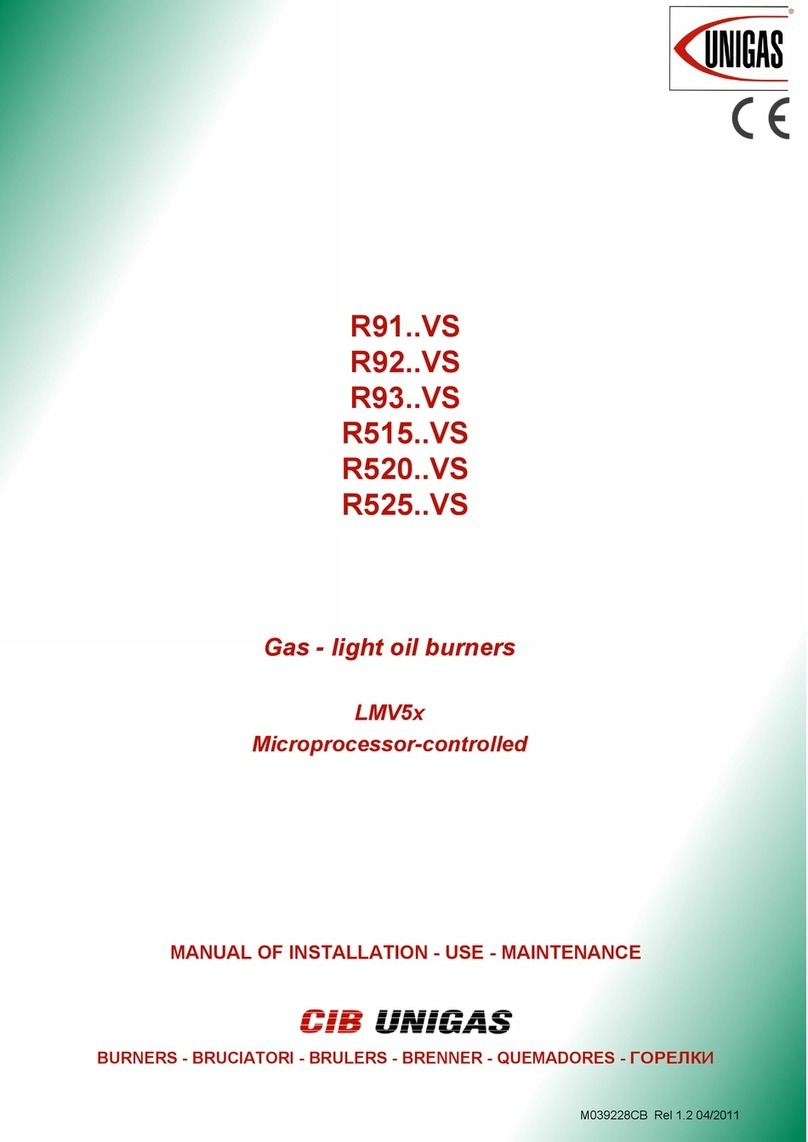
Unigas
Unigas R91 VS Series Manual of installation - use - maintenance
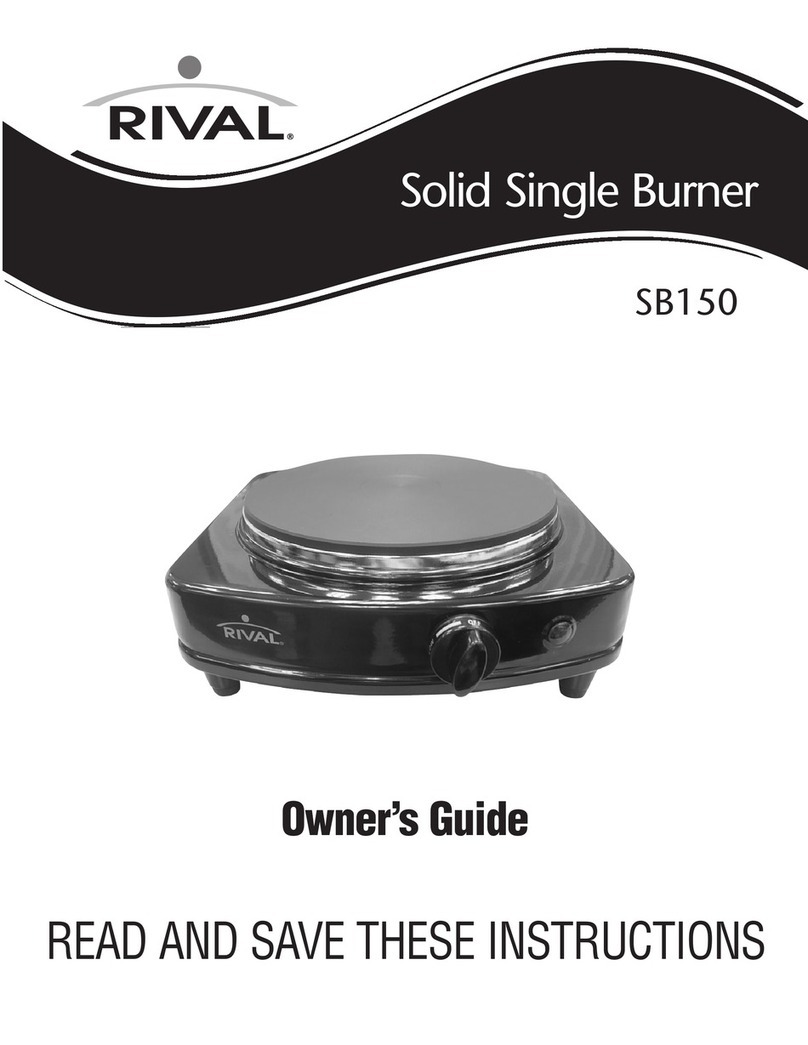
Rival
Rival SB150 owner's guide

Yunca Heating
Yunca Heating HOBSON Maintenance Guide
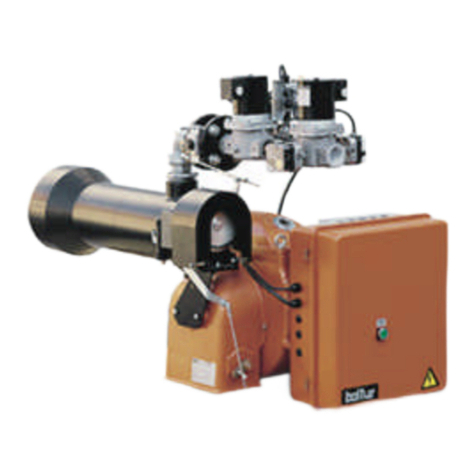
baltur
baltur BGN 40 DSPGN-ME instruction manual
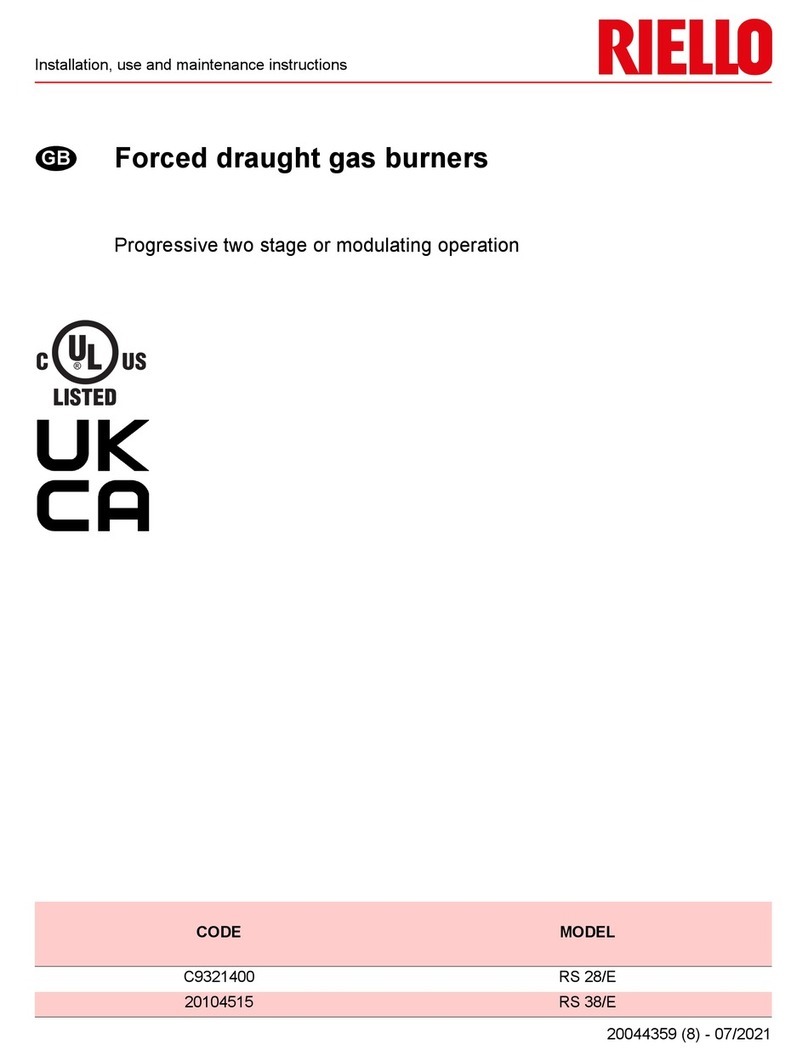
Riello
Riello RS 28/E Installation, use and maintenance instructions
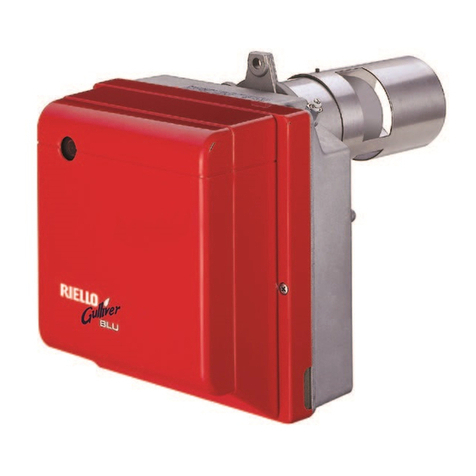
Riello Burners
Riello Burners BG1 Installation, use and maintenance instructions

